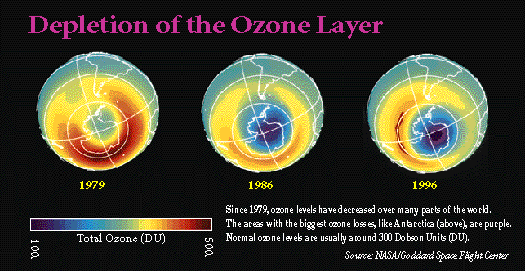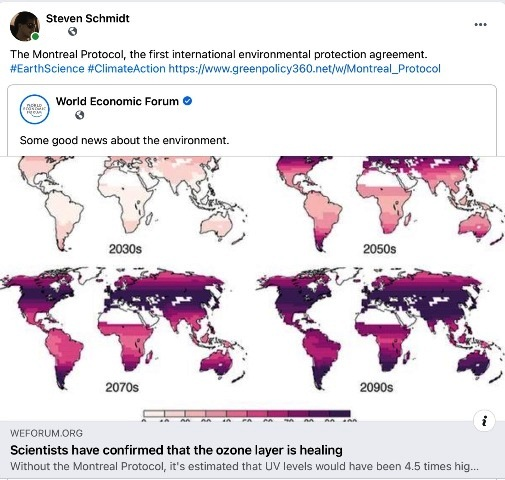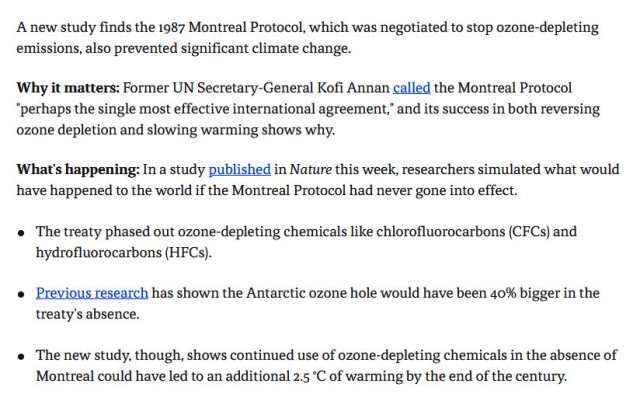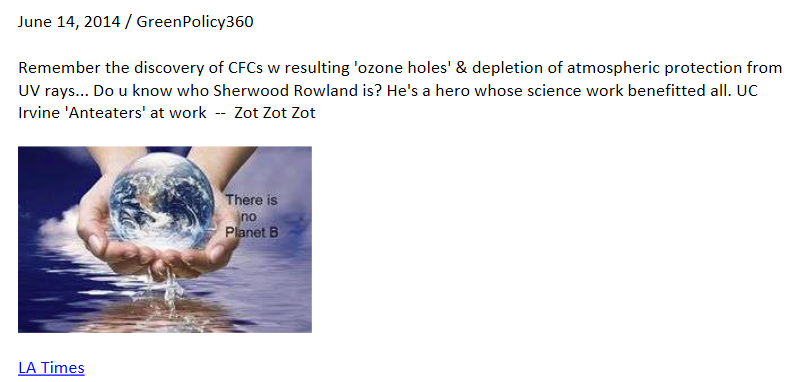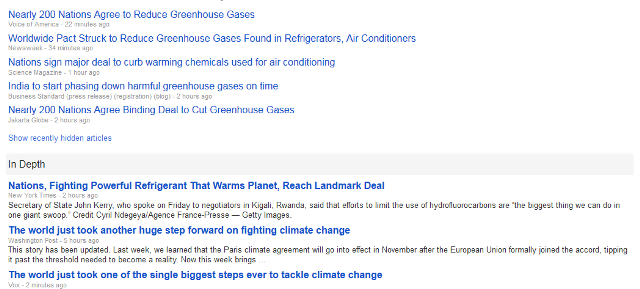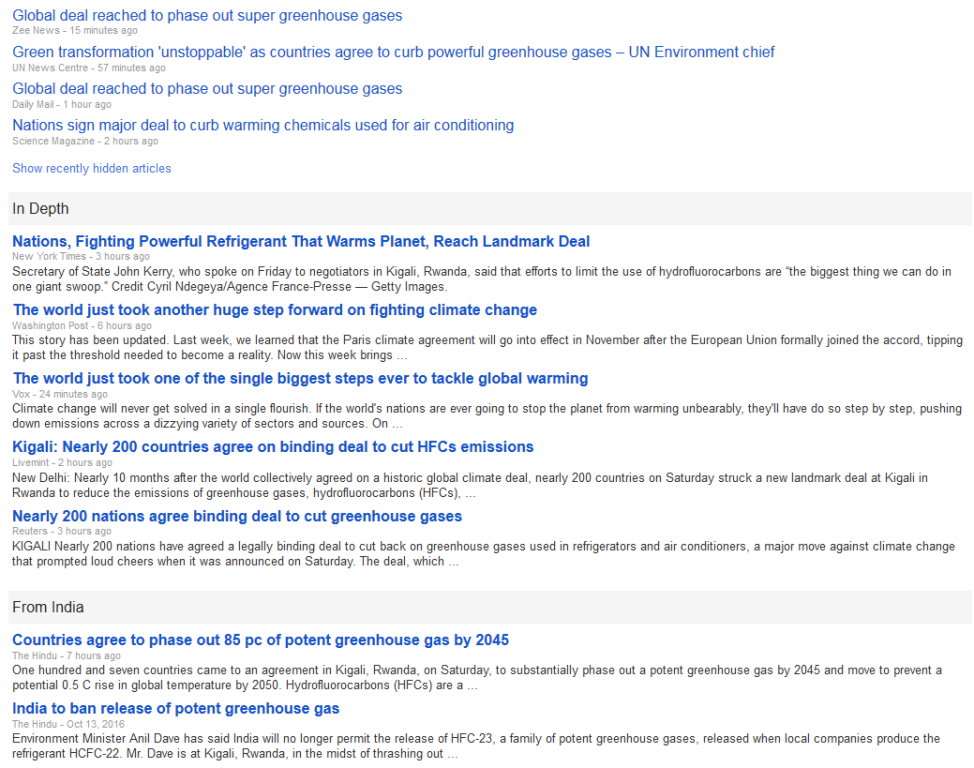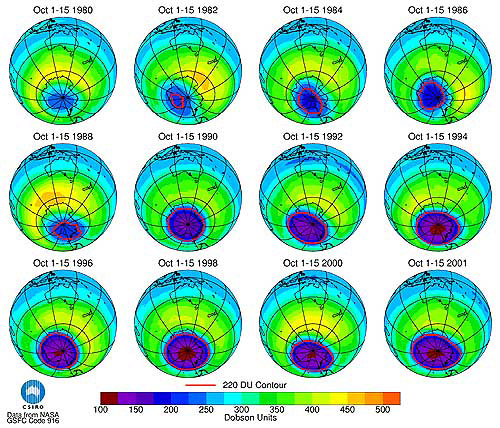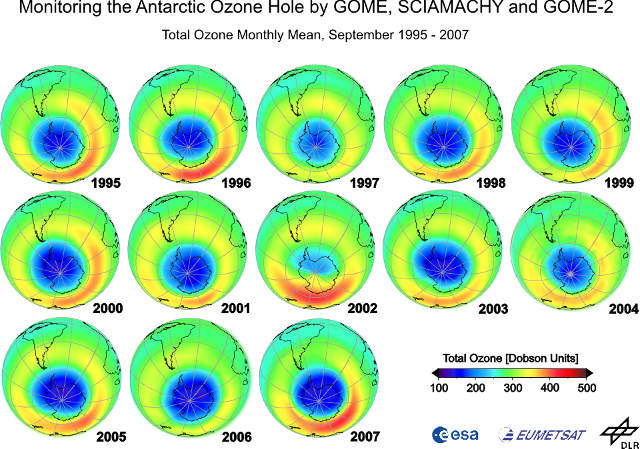Montreal Protocol
Historic International Climate Agreement
The Montreal Protocol
- Dealing with the Dangers of Chlorofluorocarbons (CFCs), an Unprecedented International Agreement & a Model for Environmental Protection
"The first international environmental protection agreement to limit destructive atmospheric emissions... The Montreal Protocol became a successful, cooperative model for climate negotiations." -- Steven Schmidt, GreenPolicy360
2023
Restoration of the Ozone Layer Is 'Back on Track'
🌎
Taking Another (and Another) View of UV Rays and Ozone Depletion Monitoring
December 2022
Independent scientific research has shown that the Montreal Protocol has protected human and ecosystem health by healing the ozone layer – at a time when biodiversity is in steep decline and needs all the help, it can get. Research shows that the Montreal Protocol has kept the climate cooler by near eliminating ozone-depleting substances that were also greenhouse gases – at a time when UNEP’s Emissions Gap Report shows that other efforts to slow climate change are failing and leaving us on course for warming far above 2°C...
The work of the Montreal Protocol, and by extension the work of the fund that keeps it ticking, is crucial to ending the triple planetary crisis of climate change, nature and biodiversity loss and pollution and waste...
Take the lessons from the (Montreal Protocol) to other agreements. The multilateral fund has a long history of success. It works, and it works well. Passing on the knowledge and experience gained through the fund would be a big help to other multilateral agreements.
○
Environmental Protection -- Green Values and Science
- UV-A, UV-B, and UV-C -- The Spectrum of Ultraviolet Radiation
The Dutch Ozone Monitoring Instrument (OMI) onboard NASA's Aura satellite
Kilgali Amendment to the Montreal Protocol (2016)
Ozone-Depleting Substances
Definitions: Environmental Protection Agency (US)
2021
View the Nature PDF Research Study (2021)
○ ○ ○ ○ ○ ○ ○ ○ ○ ○ ○ ○ ○ ○ ○ ○ ○ ○
January 2021 / Paul Crutzen has passed away
BERLIN (AP) — Paul J. Crutzen, a Dutch scientist who won the Nobel Prize for chemistry for his work understanding the ozone hole and is credited with coining the term Anthropocene to describe the geological era shaped by mankind, has died.
The Max Planck Institute for Chemistry in Mainz, Germany, where Crutzen was the director of atmospheric chemistry from 1980 until his retirement in 2000, confirmed that he died Thursday at the age of 87...
"Paul Crutzen was a pioneer in many ways," said Martin Stratmann, President of the Max Planck Society. "He was the first to show how human activities damage the ozone layer. This knowledge about the causes of ozone depletion was the basis for the worldwide ban on ozone-depleting substances – a hitherto unique example of how Nobel Prize-winning basic research can directly lead to a global political decision.”
GreenPolicy360: The worldwide ban on ozone-depleting chemicals was the first international environmental agreement. The Montreal Protocol was out in front in its ability to envision cooperative international action to confront a global threat and led directly to a generation of climate policy actions...
2020
Via Geophysical Research Report
With the passage of the first international agreement to limit atmosperic emisskons, the Montreal Protocol, CFCs were banned to protect the earth's ozone layer. A substitute product, HFC-134a, began to be used in cooling systems.
While HFC-134a was less damaging to the ozone layer, it was unfortunately a very powerful greenhouse gas, around 1,400 times more warming that CO2.
In an amendment to the Protocol, manufacturers in the US and Europe agreed to phase out HFC-134a. By 2017 all new cars had to use a different coolant for air conditioning called HFO-1234yf.
While this chemical doesn't damage ozone, and is not a greenhouse gas, it was found to break down to produce short chain PFCAs.
According to researchers, these chemicals can travel a long distance in the atmosphere and often end up in lakes and rivers. They cause "irreversible contamination" and can impact the health of freshwater creatures.
As research comes forward, it is becoming apparent that another shit in products, to a more biodegradle, less toxic product, will be needed. The environmental impacts to health, life systems, biodiversity, carry across borders...
2019
Identifying a problem. Fixing the problem. Yes we can.
2018 Update
January 4, 2018 / NASA Sees First Direct Proof of Ozone Hole Recovery
2017
The Earth's ozone hole is shrinking and is the smallest it has been since 1988
○ ○ ○ ○ ○ ○ ○ ○ ○ ○ ○ ○ ○ ○ ○
Siterunner / SJS: Remembering the scientist/professors from the University of California, Irvine.
Together, Nobel laureate Frank Sherwood Rowland and Nobel prize-winner from San Diego Mario Molina worked out in front to demonstrate the dangers of Chlorofluorocarbons. Their scientific findings in the 1970s first put Ozone depletion and CFCs into public awareness. Their prodigious work and visionary science led to the Montreal Protocol -- the first substantial international agreement to limit destructive atmospheric emissions. The two Montreal ozone treaties have been ratified by 197 parties, which includes 196 states and the European Union, making them the first universally ratified treaties in United Nations history.
Let's look at open source Wikipedia to remember the particulars of the Montreal Protocol and its history-making foundation in environmental and global security.
○ ○ ○ ○ ○ ○ ○ ○ ○ ○ ○ ○ ○ ○
Chlorofluorocarbons (CFCs) Phase-out Management Plan
The Montreal Protocol on Substances that Deplete the Ozone Layer (a protocol to the Vienna Convention for the Protection of the Ozone Layer) is an international treaty designed to protect the ozone layer by phasing out the production of numerous substances that are responsible for ozone depletion.
It was agreed on 16 September 1987, and entered into force on 1 January 1989, followed by a first meeting in Helsinki, May 1989. Since then, it has undergone eight revisions, in 1990 (London), 1991 (Nairobi), 1992 (Copenhagen), 1993 (Bangkok), 1995 (Vienna), 1997 (Montreal), 1998 (Australia), 1999 (Beijing) and 2007 (Montreal).
As a result of the international agreement, the ozone hole in Antarctica is slowly recovering. Climate projections indicate that the ozone layer will return to 1980 levels between 2050 and 2070.Due to its widespread adoption and implementation it has been hailed as an example of exceptional international co-operation, with Kofi Annan quoted as saying that "perhaps the single most successful international agreement to date has been the Montreal Protocol".
In comparison, effective burden sharing and solution proposals mitigating regional conflicts of interest have been among the success factors for the Ozone depletion challenge, where global regulation based on the Kyoto Protocol has failed to do so. In case of the ozone depletion challenge, there was global regulation already being installed before a scientific consensus was established. As well in comparison, lay people and public opinion were more convinced about possible imminent risks.
○ ○ ○ ○ ○ ○ ○ ○ ○ ○ ○ ○
Looking Back & Looking Forward
- From the first international environmental treaty in 1987 and continuing...
In Depth / Background
https://www.epa.gov/ozone-layer-protection/recent-international-developments-under-montreal-protocol
- SJS - with a nod and h/t to green visionaries who first addressed climate and atmospheric challenges -- and worked to set up the EPA and founding environmental laws as models of what can be accomplished...
- George E. Brown / EPA and first Climate Study, and first earth science studies from space...
- Beginnings of the US & Global Environmental Movement
○ ○ ○ ○ ○ ○ ○ ○ ○ ○ ○ ○ ○ ○
2016 Critical Update
HFC Add-On to the Montreal Protocol
Headline News / October 15, 2016
○ ○ ○ ○ ○ ○ ○ ○ ○ ○ ○ ○ ○ ○ ○
🌎
- Air Pollution
- Anthropocene
- Atmosphere
- Atmospheric Science
- Biodiversity
- Citizen Science
- Climate Change
- Climate Policy
- Countries
- Earth360
- Earth Science
- Earth Science from Space
- Earth Observations
- Earth System Science
- Environmental Full-cost Accounting
- Environmental Laws
- Environmental Protection
- Environmental Security
- ESA
- Externalities
- Global Security
- Global Warming
- Green Best Practices
- Green Politics
- GreenPolicy360
- NASA
- Nature
- New Definitions of National Security
- Planet Citizen
- Planet Citizens
- Planet Citizens, Planet Scientists
- Planetary Science
- Policies
- Pollution
- Strategic Demands
- Sustainability Policies
- ThinBlueLayer
- Toxics and Pollution
- United Nations
- US Environmental Protection Agency
- Whole Earth
